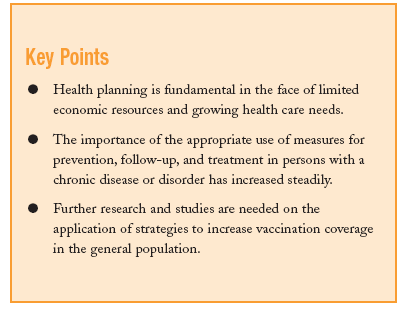Aging and increasing life expectancies in the population have led to a steady rise in the importance of preventive, follow-up and treatment measures for persons with a chronic disease or disorder. Moreover, diseases that were formerly fatal within a short period can now be considered chronic. Health planning is fundamental in the face of limited economic resources and growing health care needs. Because preventive methods of proven efficacy and effectiveness are now available, different health care systems share the view that priority should be given to interventions that reduce high-incidence chronic diseases, accidents, and infectious diseases such as AIDS and all diseases potentially preventable by vaccination.1,2 In persons 65 years of age or more, who may be at risk for more than one problem simultaneously, preventive measures constitute a fundamental activity in any health system, and in this connection primary care clearly has a leading role to play. According to data from the Spanish National Institute of Statistics,3 persons older than 65 years now make up almost 20% of the population--a fact with health care implications worthy of consideration.
Among the various preventive activities that can be implemented in primary care, vaccination has one of the most clearly favorable cost-benefit ratios. As shown in the study by Schwarz et al,4 among others, influenza vaccination should be considered a fundamental preventive activity. Although this conclusion is beyond question, additional research and work are needed on the application of different strategies to increase vaccination coverage in persons 65 years of age or more, for whom this measure is especially indicated.5 A more active approach is needed in primary care centers toward vaccinating this population and reaching patients with chronic diseases, as these are often the persons who have the most problems obtaining access to preventive programs. It is noteworthy that more than 30% of the population aged 65 years or more had one or more disabilities (involving sight, hearing, communication, mobility, self-care, learning and applying knowledge, or performing household chores), the most frequent being limited mobility (65% of the participants).3
A number of strategies can be considered to provide enhanced service to patients with chronic diseases and disabilities. These strategies should be considered part of preventive and follow-up programs; in addition, measures such as home visits and telephone contacts should be implemented to actively seek out patients. However, these measures are not always easy to implement because of the resources they require in our already overburdened centers; as a result we must resort increasingly to telemedicine and to what can generally be termed the new information and communication technologies. A number of studies have examined ways to manage these situations, and the topic has received much attention from the European Union and World Health Organization.6
Of note are the findings of a recent study7 that evaluated influenza vaccination coverage in Spain from 1993 to 2001. Despite the efforts of many, only a slight improvement was achieved in vaccination coverage among persons aged 65 years or more. In persons less than 65 years old who had a chronic disease--an indication for vaccination--there was no increase in coverage. Accordingly, we should take note of the findings in Catalonia and in European countries where the age when influenza vaccination is indicated has been lowered to 60 years. This, in theory, may constitute an additional means of increasing coverage among older persons who have other associated risk factors.









